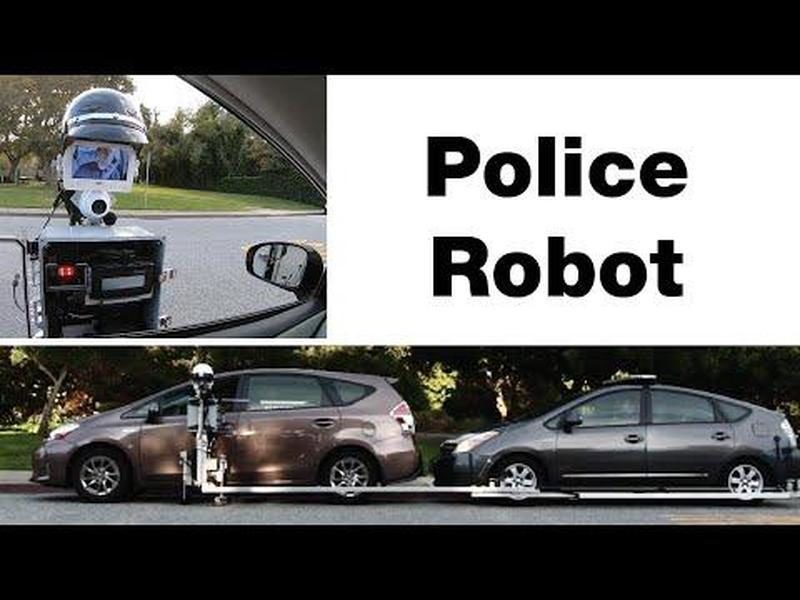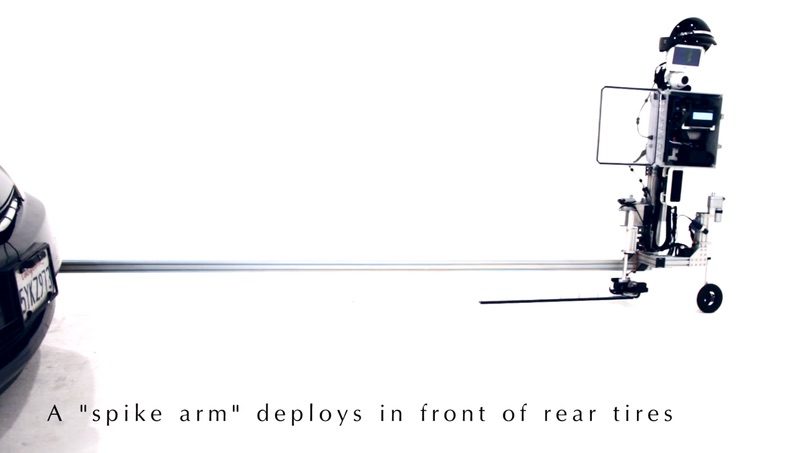The project began several years ago in Brewer's garage but has since been in development at SRI International's facilities in California. The robot, dubbed GoBetween, is designed to make it safer for both the officer and the motorist.
When the officer pulls over a vehicle, GoBetween is deployed, which is a mechanism attached to the driver's side of the police car, extends a rolling aluminum track to the motorist's window with a robot at the end. At the same time, a spike strip extends from the robot and unfolds between the vehicle's front and rear tires, stopping a potential high-speed chase."The main advantage of a robot over a human is that physical danger no longer matters," Brewer wrote after being reached by email by The Post.
"The robot is purely defensive, so it can't hurt the motorist. If the motorist damages the robot, it's only money to replace it."
"People are more dangerous when they're scared, so the goal is to remove the possibility of being physically hurt so that they're less scared and less dangerous," he added.
GoBetween is a weaponless robot includes two video cameras, a microphone, bar-code scanner, and a speaker that allows the police officer and motorist to communicate. The car-bode scanner allows the driver to scan their license, a signature pad allows the driver to sign a ticket, and a printer provides the driver with a ticket. Brewer told The Post future prototypes will include new sensors, including a Passive Alcohol Sensor to "sniff for drunk driving."
Brewer pointed out GoBetween may reduce tension at traffic stops. He admitted his robot could not remove human bias from interactions between police officers and drivers.
The robot has been shown to several police departments and received an underwhelming response, Brewer said."Whatever inequalities there currently are with police cars pulling over minorities more often will still be there once there's a robot on their car," he wrote.
"The difference is that those interactions (however unequal they may be) shouldn't result in anyone getting hurt or killed."
Police officers across the country make more than 50,000 traffic stops per day, according to The Stanford Open Policing Project.
In 2017, the FBI's Uniform Crime Report showed 5,108 officers were assaulted during traffic stops and pursuits, at an average of 14 officers per day.
Brewer said he's working on securing a pilot test for GoBetween with a police department.
The policing environment of the 2020s could so much different than what is seen today. A new wave of investments in automation could alleviate some of the dangers that police officers encounter while on duty. But - with the proliferation of self-driving cars, GoBetween could one day eliminate the need for human officers patrolling the streets, in search for drivers abusing traffic laws."I'd love to have a police department test my prototype during actual traffic stops so that we can learn what its real-life limitations are," he added.
"It's ready to go, just need a willing partner to test it out!"





Reader Comments
A fair third of pull overs these days are NOT for offenses at all, but are done as a part of 'urban pacificatiion' (to use a phrase I just heard somewhere... ) either to get people ever more used to living in a police state, or, in hopes of finding something to justify your kidnapping and steal things. (And it would be harder for the Robot to justify turning off its video cam.)
But in the end, here's what we'll be seeing: [Link]
R.C.